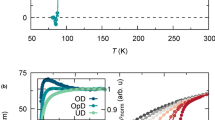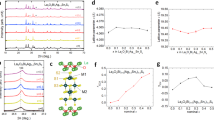Abstract
Considerable excitement has been generated by the report of superconductivity above 90 K in a multi-phase Y–Ba–Cu oxide1. The superconducting phase was subsequently identified as YBa2Cu3O7−δ2,3. The complete replacement of Y by the trivalent rare-earths La–Lu, with the exception of Ce, Pr and Tb, yields a superconducting phase with a critical temperature (Tc) almost identical to that reported for the yttrium compound4–7. This is somewhat surprising as most of these ions carry significant magnetic moments, the presence of which rapidly decreases Tc in ordinary superconductors. The three exceptions noted, Ce, Pr and Tb, are the rare-earth ions which have a stable tetravalent state. Here we present the results of a study of the structure and transport properties of the series of compounds Y1−xPrxBa2Cu3O7−δ (x = 0−1.0), in which we observe a monotonic decrease in Tc and eventually a metal–nsulator transition with increasing Pr concentration. To date, this is the only rare-earth ion which has been found substantially to alter Tc upon partial substitution for Y.
This is a preview of subscription content, access via your institution
Access options
Subscribe to this journal
Receive 51 print issues and online access
$199.00 per year
only $3.90 per issue
Buy this article
- Purchase on Springer Link
- Instant access to full article PDF
Prices may be subject to local taxes which are calculated during checkout
Similar content being viewed by others
Author information
Authors and Affiliations
Rights and permissions
About this article
Cite this article
Soderholm, L., Zhang, K., Hinks, D. et al. Incorporation of Pr in YBa2Cu3O7−δ: electronic effects on superconductivity. Nature 328, 604–605 (1987). https://doi.org/10.1038/328604a0
Received:
Accepted:
Issue Date:
DOI: https://doi.org/10.1038/328604a0
This article is cited by
-
Stabilization of three-dimensional charge order through interplanar orbital hybridization in PrxY1−xBa2Cu3O6+δ
Nature Communications (2022)
-
Structural and Fluctuation Induced Excess Conductivity in R:1113 Superconductors
Brazilian Journal of Physics (2016)
-
Temperature dependence of the pseudogap in Y1−zPrzBa2Cu3O7−δ single crystals
Journal of Materials Science: Materials in Electronics (2013)
-
Fluctuation Conductivity and Phase Separation in Polycrystalline Y1−x Ce x Ba2Cu3O7−δ Superconductors
Journal of Superconductivity and Novel Magnetism (2010)
-
Critical and Gaussian Conductivity Fluctuations in Granular Ho1−x Pr x Ba2Cu3O7−δ Superconductor
Journal of Superconductivity and Novel Magnetism (2010)
Comments
By submitting a comment you agree to abide by our Terms and Community Guidelines. If you find something abusive or that does not comply with our terms or guidelines please flag it as inappropriate.



